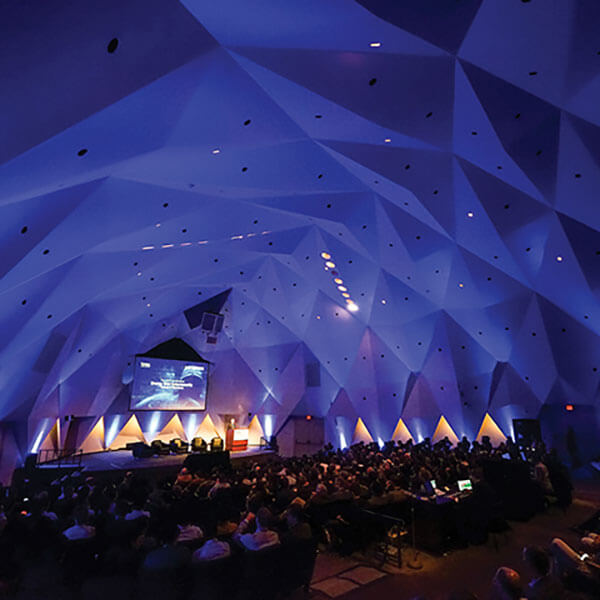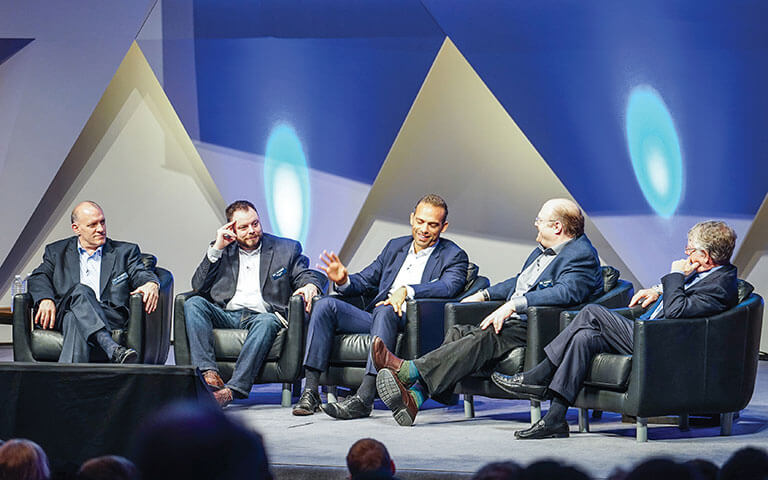Lisa VanRosendale, senior vice president of client development for the brand experience agency FreemanXP, was one of PCMA’s Event Designer of the Year finalists. Which might be surprising, considering that she “killed off” the attendees at the conference that earned her the nomination.

Lisa VanRosendale
Not literally, of course, but in a demonstration that would snap the 2017 Siebel Scholars Conference attendees awake as the event — which addressed cyber security — got underway in Washington, D.C., on March 3. Inside the National Academy of Sciences Building, where most of the event took place, VanRosendale made sure that each of the 1,000-plus attendee strapped a PixMob band to their wrist. Participants were told that the light-up bracelets pulsed red to simulate a heartbeat, and everyone’s was pulsating as a video started.
The ominous voiceover described what a cyber attack to the country’s energy grid would mean: barren grocery stores, scarce drinking water, no medical care. As the video continued, ticking through the days after an energy grid attack, attendees’ wristbands began to shut off. By Day 365, only 10 percent of the red lights were still pulsing. A dark wristband meant death.
“I joke that I had to make my point by killing them,” said VanRosendale, who has planned the Siebel conference since it began in 2000. “They looked around, and there were very few people with their lights still on, and they were humbled. They just broke out in applause.”
Then journalist Ted Koppel, who wrote the book Lights Out: A Cyberattack, a Nation Unprepared, Surviving the Aftermath, walked on stage and asked the audience how it felt to realize the country’s vulnerability to an energy attack. That’s when the first panel discussion started.
Finding Friction
The wristband wipeout, which VanRosendale said “set the bar for what they could expect the rest of the conference,” is only one of her efforts to make the Siebel Scholars meeting powerful and resonant — and it worked. After the 2017 meeting, 100 percent of attendees said they would attend another Siebel conference.

The 2017 Siebel Scholars Conference focused on energy grid cybersecurity.
VanRosendale said it’s about breaking people out of their day-to-day haze. With that striking opening, “we made it clear that this isn’t about sitting back and going on your iPhone,” she said. She sustained the high-octane, crankit- up-to-11 energy throughout the conference.
“From the beginning to the end, it was awesome or nothing,” she said. “We never let up the whole time.” That intensity matches the conference’s larger goals. Each meeting tackles a single, high-stakes issue and brings in major players to discuss it. Past focuses have included class warfare, water, the meth crisis, and stem-cell research. The goal is to develop real solutions.
Participants include both the current crop of Siebel Scholars and hundreds of alumni. Since its creation 18 years ago, the Siebel program has awarded scholarships each year to outstanding graduate students studying business, bioengineering, computer science, and energy science, and now has a community of more than 1,200 past recipients. Thomas Siebel, who founded the software company C3IoT, “wanted to build this community of scholars as the next leaders,” VanRosendale said, “so the challenge with that is that every conference has to be riveting.”
That’s where friction comes in. VanRosendale aims to create some with every event she plans, even if it requires her to do some persuading — and when it came to getting Siebel on board with the whole dead audience thing last year, it did. “I told him, if you really want me to create goosebumps and you really want to impact change, then I have to kill them,” she said. “That was friction. I took him by surprise. He agreed, but he was uncomfortable with the agreement.
Then he was so happy with the outcome because it did exactly what he wanted to do. It got everybody to the point of, ‘Now it matters to me. I’m in it. Let’s talk about this.’”
Leveraging Tech—Without ‘10 Different Companies’
Starting with her creative use of the PixMob wristbands as heartbeats, Van-Rosendale repurposed tech products for several of the conference’s key moments.
On the meeting’s third day, attendees wrote white papers in small groups. Her challenge? Find a way to collect those papers quickly enough that Siebel could review them and pick out his top three while participants were on a short break.
FreemanXP uses a second-screen technology called FXP Touch, which lets attendees respond to polls and surveys, type out questions, and otherwise engage with a presentation in realtime. VanRosendale figured that FXP Touch was her best shot, but it needed some tweaking first. She approached the FreemanXP product team and explained the situation: Groups needed to log in together as, say, Table 39, and work on their papers in real-time.
They adjusted the product accordingly. Each table was given an iPad to use to build and submit their papers via FXP Touch. VanRosendale was able to print them all out in only a handful of minutes and also retain the documents without retyping or scanning them in later. She could even measure how involved participants were during the writing process. “We could tell that they were on this platform and putting in content the whole time,” she said.
Sure, it was an off-label use of the product. But “everything to me is customizable,” she said. “I think you should always try to leverage something you’re already using and see if they can customize it versus adding another platform. That would be my No. 1 tip to people: Digital doesn’t equal 10 different companies.”

The Energy Grid Cybersecurity: Threats & Solutions Conference attracted approximately 400 scholars from the Siebel Scholars Foundation, government leaders, energy researchers, and cybersecurity experts from around the world.
Big Impact, Modest Budget
The Siebel Scholars Conference is known for booking heavyweight speakers, from prominent writers and broadcast journalists to scholars and politicians, including former Secretary of State Condoleezza Rice. “We never have a problem securing speakers — at all,” VanRosendale said. She uses speakers’ bureaus when necessary, but often Siebel will reach out to people personally.
Still, big names are expensive, and VanRosendale said she has a conservative budget. For those in a similar situation, she recommends finding a signature speaker who can draw an audience — “I call that ‘the hook,’” she said — and asking that speaker who they’re watching right now. “Find out what’s on their nightstand or what they’re looking at and bring those people,” she said.
“Usually they’ll give me two or three names that no one even knows and[they] are free,” she added. Then she uses the hook to market the entire slate: Here’s Eric Schmidt and three people he’s watching. “You’re only paying for one person, but you’re really getting an ecosystem,” she said. “And it means something to everybody that Eric is watching those other people. Now you’ve quadrupled your relevance and it hasn’t cost you that much.”
While smart technology, standout speakers, and wow moments are all integral elements of the Seibel conference’s success, VanRosendale said she has a very simple strategy for pulling it all together: Pick out a few words or even a haiku that will define the event.
“Whatever a client wants to use as that North Star for us, that compass, is fine, but there has to be one,” she said. “Whether you’re spending millions of dollars or $100,000 for your event, what’s your manifesto? That’s where everything needs to start and end.”
